Glycine release from radial cells modulates the spontaneous activity and its propagation during early spinal cord development
- PMID: 20053920
- PMCID: PMC6632542
- DOI: 10.1523/JNEUROSCI.2115-09.2010
Glycine release from radial cells modulates the spontaneous activity and its propagation during early spinal cord development
Abstract
Rhythmic electrical activity is a hallmark of the developing embryonic CNS and is required for proper development in addition to genetic programs. Neurotransmitter release contributes to the genesis of this activity. In the mouse spinal cord, this rhythmic activity occurs after embryonic day 11.5 (E11.5) as waves spreading along the entire cord. At E12.5, blocking glycine receptors alters the propagation of the rhythmic activity, but the cellular source of the glycine receptor agonist, the release mechanisms, and its function remain obscure. At this early stage, the presence of synaptic activity even remains unexplored. Using isolated embryonic spinal cord preparations and whole-cell patch-clamp recordings of identified motoneurons, we find that the first synaptic activity develops at E12.5 and is mainly GABAergic. Using a multiple approach including direct measurement of neurotransmitter release (i.e., outside-out sniffer technique), we also show that, between E12.5 and E14.5, the main source of glycine in the embryonic spinal cord is radial cell progenitors, also known to be involved in neuronal migration. We then demonstrate that radial cells can release glycine during synaptogenesis. This spontaneous non-neuronal glycine release can also be evoked by mechanical stimuli and occurs through volume-sensitive chloride channels. Finally, we find that basal glycine release upregulates the propagating spontaneous rhythmic activity by depolarizing immature neurons and by increasing membrane potential fluctuations. Our data raise the question of a new role of radial cells as secretory cells involved in the modulation of the spontaneous electrical activity of embryonic neuronal networks.
Figures
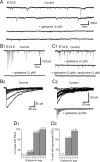
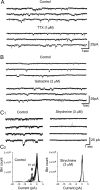
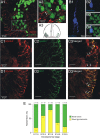
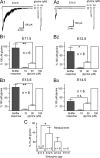
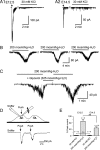





Similar articles
-
Acetylcholine controls GABA-, glutamate-, and glycine-dependent giant depolarizing potentials that govern spontaneous motoneuron activity at the onset of synaptogenesis in the mouse embryonic spinal cord.J Neurosci. 2014 Apr 30;34(18):6389-404. doi: 10.1523/JNEUROSCI.2664-13.2014. J Neurosci. 2014. PMID: 24790209 Free PMC article.
-
Persistent Sodium Current Drives Excitability of Immature Renshaw Cells in Early Embryonic Spinal Networks.J Neurosci. 2018 Aug 29;38(35):7667-7682. doi: 10.1523/JNEUROSCI.3203-17.2018. Epub 2018 Jul 16. J Neurosci. 2018. PMID: 30012693 Free PMC article.
-
Characterization of the circuits that generate spontaneous episodes of activity in the early embryonic mouse spinal cord.J Neurosci. 2003 Jan 15;23(2):587-600. doi: 10.1523/JNEUROSCI.23-02-00587.2003. J Neurosci. 2003. PMID: 12533619 Free PMC article.
-
Development of spinal motor networks in the chick embryo.J Exp Zool. 1992 Mar 1;261(3):261-73. doi: 10.1002/jez.1402610306. J Exp Zool. 1992. PMID: 1629659 Review.
-
Chapter 1--importance of chloride homeostasis in the operation of rhythmic motor networks.Prog Brain Res. 2011;188:3-14. doi: 10.1016/B978-0-444-53825-3.00006-1. Prog Brain Res. 2011. PMID: 21333799 Review.
Cited by
-
Spontaneous activity regulates Robo1 transcription to mediate a switch in thalamocortical axon growth.Nat Neurosci. 2012 Jul 8;15(8):1134-43. doi: 10.1038/nn.3160. Nat Neurosci. 2012. PMID: 22772332
-
Glycine-induced NMDA receptor internalization provides neuroprotection and preserves vasculature following ischemic stroke.iScience. 2021 Dec 3;25(1):103539. doi: 10.1016/j.isci.2021.103539. eCollection 2022 Jan 21. iScience. 2021. PMID: 34977503 Free PMC article.
-
Genetic and functional analyses demonstrate a role for abnormal glycinergic signaling in autism.Mol Psychiatry. 2016 Jul;21(7):936-45. doi: 10.1038/mp.2015.139. Epub 2015 Sep 15. Mol Psychiatry. 2016. PMID: 26370147 Free PMC article.
-
Glycine neurotransmission: Its role in development.Front Neurosci. 2022 Sep 16;16:947563. doi: 10.3389/fnins.2022.947563. eCollection 2022. Front Neurosci. 2022. PMID: 36188468 Free PMC article. Review.
-
Glycine Regulates Neural Stem Cell Proliferation During Development via Lnx1-Dependent Notch Signaling.Front Mol Neurosci. 2019 Feb 18;12:44. doi: 10.3389/fnmol.2019.00044. eCollection 2019. Front Mol Neurosci. 2019. PMID: 30833887 Free PMC article.
References
-
- Allain AE, Baïri A, Meyrand P, Branchereau P. Expression of the glycinergic system during the course of embryonic development in the mouse spinal cord and its co-localization with GABA immunoreactivity. J Comp Neurol. 2006;496:832–846. - PubMed
-
- Aragón MC, Giménez C, Mayor F. Stoichiometry of sodium- and chloride-coupled glycine transport in synaptic plasma membrane vesicles derived from rat brain. FEBS Lett. 1987;212:87–90. - PubMed
-
- Barry D, McDermott K. Differentiation of radial glia from radial precursor cells and transformation into astrocytes in the developing rat spinal cord. Glia. 2005;50:187–197. - PubMed
-
- Ben-Ari Y. Developing networks play a similar melody. Trends Neurosci. 2001;24:353–360. - PubMed
-
- Ben-Ari Y, Khalilov I, Represa A, Gozlan H. Interneurons set the tune of developing networks. Trends Neurosci. 2004;27:422–427. - PubMed
Publication types
MeSH terms
Substances
LinkOut - more resources
Full Text Sources
Molecular Biology Databases
